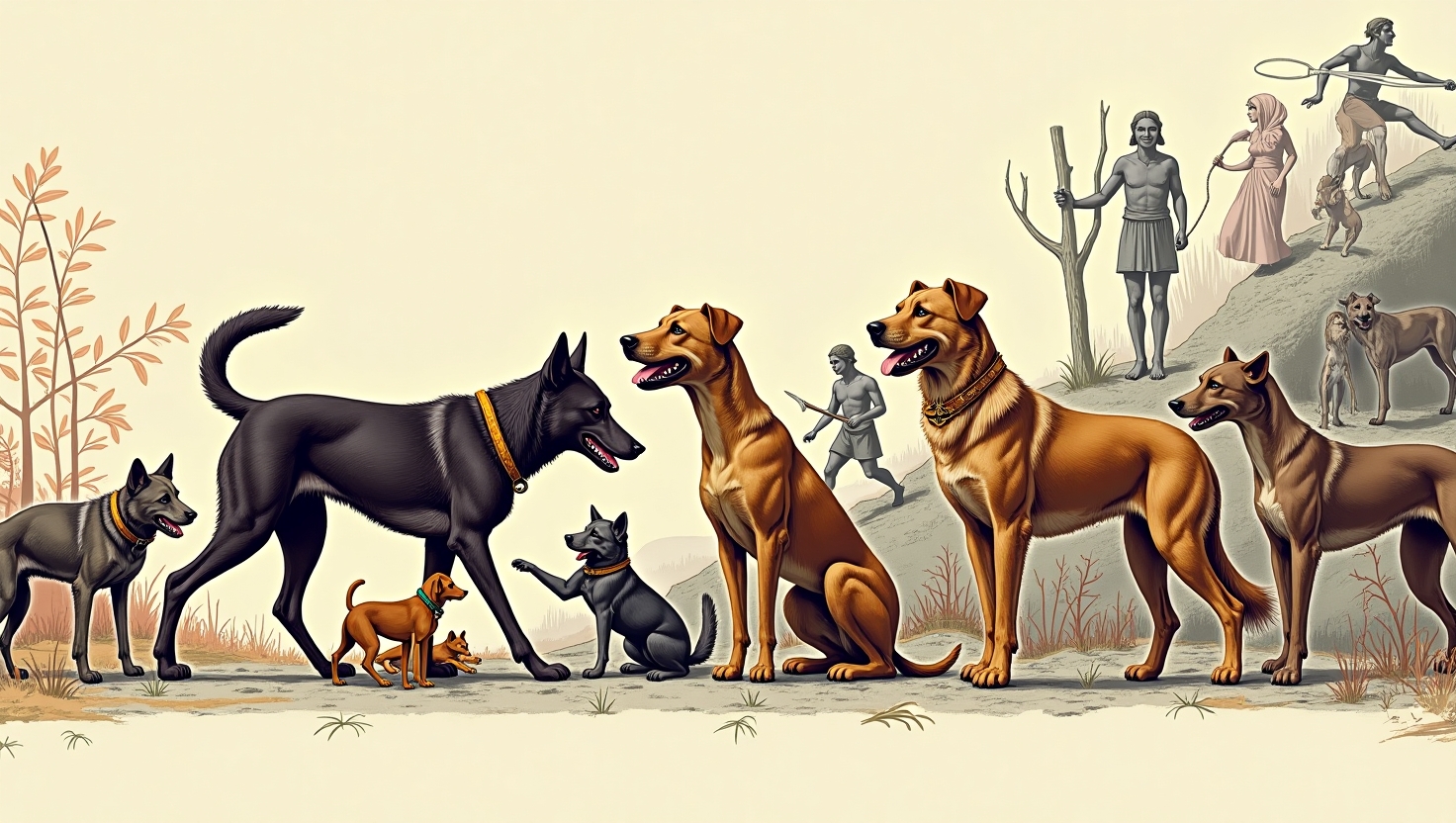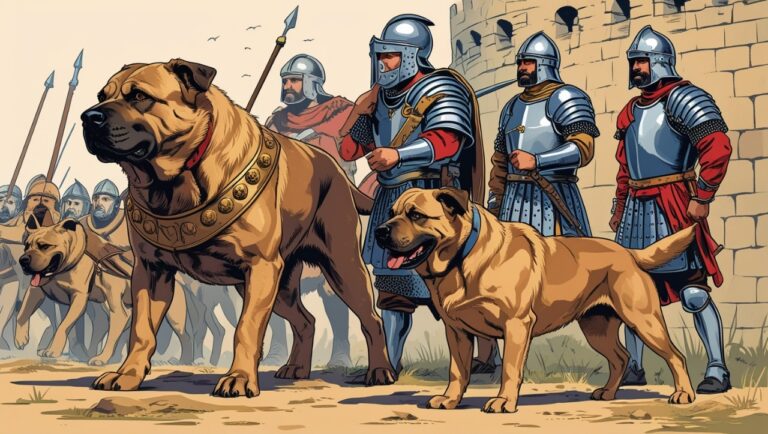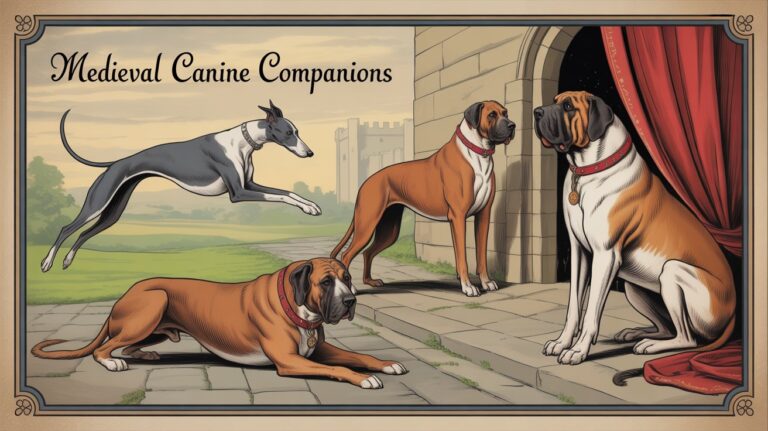When Did Dogs First Become Domesticated? A Complete Timeline of Human-Canine History

1. Introduction to Dog Domestication
Domesticated dogs (Canis lupus familiaris) are the first and arguably the most enduring companions of humans. Long before agriculture or cities, early humans began forming emotional and practical bonds with wolf ancestors, leading to the emergence of the species we now call “dog.” But the question remains:
When did dogs first become domesticated?
The answer, grounded in archaeological evidence, ancient DNA, and evolutionary theory, points to a period between 20,000 and 14,000 years ago.
2. Timeline of Domestication
2.1 The 20,000-Year-Old Question
The earliest genetically confirmed domesticated dog remains date to roughly 14,200 years ago, found at Bonn-Oberkassel, Germany. However, molecular clock studies suggest that the split from gray wolves (Canis lupus) began much earlier — around 20,000 to 40,000 years ago.
2.2 Key Chronological Phases
- Upper Paleolithic (~30,000 years ago): Possible divergence from wolves begins.
- Late Glacial Maximum (~19,000 years ago): Populations become geographically isolated.
- Mesolithic (~14,000 years ago): First definitive dog burials appear.
2.3 Discrepancies in Dating
Different interpretations of radiocarbon dating and mitochondrial DNA (mtDNA) place early domestication either in Western Eurasia or East Asia, adding complexity to the timeline.
3. The Ancestors of Modern Dogs
3.1 Gray Wolves: The Direct Ancestors
Modern dogs evolved from gray wolves, not the aggressive predators we know today, but rather a now-extinct wolf population. These ancestral wolves likely exhibited tame behaviors, initiating their own path toward self-domestication.
3.2 Genetic Divergence and mtDNA
Mitochondrial DNA studies reveal dogs diverged from wolves at least 20,000 years ago, but full domestication likely happened later through selective pressures and natural selection.
3.3 Fossil Evidence of Transitional Forms
Canid skulls from Belgium (31,000 years ago) and Russia (17,000 years ago) show intermediate features, suggesting they may represent proto-dogs rather than fully domesticated species.
4. Archaeological Evidence
4.1 Bonn-Oberkassel Dog
The Bonn-Oberkassel burial (Germany) features two humans and a dog buried together around 14,200 years ago. This burial signifies not just companionship but also symbolic and possibly emotional ties.
4.2 Zhokhov Island (Siberia)
On Zhokhov Island, remains of sled dogs dating to 9,000 years ago were discovered. These dogs were bred selectively for transportation, making them among the first working dogs.
4.3 North American Evidence
In Illinois, the Koster Site reveals dog burials from 10,000 years ago, proving that domesticated dogs had reached North America alongside migrating humans.
5. Theories of First Domestication
5.1 Self-Domestication Hypothesis
Wolves that scavenged near human settlements and exhibited low aggression may have undergone natural selection, becoming genetically predisposed to tameness.
5.2 Mutualism Model
In this model, both humans and wolves benefited mutually: humans gained a hunting partner, while wolves received food scraps and protection.
5.3 Garbage Dump Theory
According to this theory, wolves evolved into dogs by feeding on waste dumps, gradually becoming more socially attuned to human presence.
6. Geographic Origins of Domesticated Dogs
6.1 Eurasian Steppes vs East Asia
Studies suggest two possible centers of origin:
- Western Eurasia (~15,000 years ago)
- East Asia, particularly China (~12,000 years ago)
6.2 Dual Origin Hypothesis
One study from Nature Communications proposed that dogs were domesticated twice, once in the West and once in the East, before later interbreeding.
6.3 Genome Mapping Insights
A 2020 genome-wide study indicates an Eurasian origin, but crossbreeding events between ancient dog lineages have muddied the waters of pinpointing a single location.
7. The Role of Hunter-Gatherers
7.1 Hunting Partnership
Dogs may have served as tracking partners, helping humans locate and corner prey. This relationship was a major evolutionary advantage in pre-agricultural societies.
7.2 Ritual Significance
Dog burials, like those at Ain Mallaha (Israel) and Natufian culture sites, suggest a symbolic importance to these early animals, beyond functional use.
7.3 Cultural Representation
Dogs appear in cave art from regions such as Arabia and France, often shown alongside humans — a powerful indicator of early domestic roles.
8. Co-evolution of Humans and Dogs
8.1 Emotional Bonding
Dogs and humans exhibit similar oxytocin responses during eye contact, a phenomenon not found in wolves. This mutual gaze played a role in emotional domestication.
8.2 Shared Behavioral Traits
Traits like docility, neoteny, and playfulness evolved in parallel, reinforcing co-evolution between the species.
8.3 Domestication Syndrome
Dogs exhibit a suite of traits—floppy ears, smaller jaws, varied coat colors—commonly seen in other domesticated animals, collectively known as domestication syndrome.
9. Genetic Evidence of Early Domestication
9.1 Comparative Genomics
Dog genomes contain fewer copies of the AMY2B gene (starch digestion) than wolves, indicating adaptation to human diets.
9.2 Tameness and Behavior Genes
Specific genes, such as WBSCR17, are linked to increased sociability in dogs compared to wolves, supporting theories of behavioral domestication.
9.3 Ancient Genome Studies
Genome sequencing from remains up to 11,000 years old show little genetic variation, implying that most diversification occurred after domestication.
10. Domesticated Dogs in Prehistoric Societies
10.1 Functional Roles
Early dogs served as guards, hunting partners, and possibly beasts of burden, especially in Arctic cultures like the Inuit.
10.2 Ceremonial Use
In some burials, dogs are painted, adorned, or placed with humans, signifying spiritual beliefs about the dog’s role in the afterlife.
10.3 Dogs in Farming Transition
As agriculture emerged, dogs adapted to new roles, such as herding, reflecting their continued co-adaptation with human society.
11. Changes in Dog Morphology
11.1 Skull Shape
Early dog skulls are shorter, with shorter snouts, indicating early divergence from wolf morphology.
11.2 Fur and Color Variability
The MC1R gene controls pigmentation; early dogs began to show diverse coat colors, unlike uniform-colored wolves.
11.3 Miniaturization and Breeding
Over time, selective breeding introduced smaller body sizes, better suited for domestic settings and various working roles.
12. Cultural and Spiritual Significance
12.1 Dogs in Mythology
Ancient cultures, including the Egyptians, Greeks, and Mesopotamians, placed dogs in mythical roles such as guardians, underworld guides, or companions to gods.
12.2 Burial Practices
Sites like Predmostí (Czech Republic) and Ain Mallaha show dogs buried with care, sometimes with grave goods, indicating status.
12.3 Dog Depictions in Rock Art
Dogs shown with leashes or hunting poses in cave art prove their utility and integration into early human culture.
13. Domestication Syndrome Explained
13.1 Definition
Domestication syndrome describes a set of physical and behavioral traits found across domesticated species, including reduced aggression, floppy ears, and docility.
13.2 Shared Traits in Other Species
Dogs, pigs, and horses all exhibit similar developmental changes, hinting at a neurological root for domestication.
13.3 Hormonal and Neural Changes
Lower cortisol levels, reduced stress reactivity, and changes in the hypothalamic-pituitary-adrenal (HPA) axis are found in domesticated dogs.
14. Regional Differences in Domestication
14.1 Europe
Most early dog remains are from Europe, particularly Germany, Belgium, and Russia.
14.2 East Asia
Recent genome studies show significant early dog populations in China, contributing to modern breeds like Shih Tzu and Pekingese.
14.3 Africa and the Middle East
While less represented in early fossil records, dogs spread rapidly through African pastoral cultures, adapting to climate and utility needs.
15. Modern Scientific Debates
15.1 Unresolved Questions
Key uncertainties remain:
- Was there one domestication event or multiple?
- How much did hybridization with wolves influence early dog genetics?
15.2 Radiocarbon Dating Limitations
Dating accuracy depends on collagen preservation and site context, making it difficult to draw exact timelines.
15.3 What Future Research Might Reveal
Ancient genome libraries and AI-assisted evolutionary modeling promise clearer answers in the coming decades.
16. Summary of Dog Domestication Milestones
| Milestone | Approx. Date |
| Initial wolf-dog divergence | ~40,000 years ago |
| Possible proto-dog fossils | ~30,000 years ago |
| First confirmed dog burial (Germany) | 14,200 years ago |
| North American dog remains | 10,000 years ago |
| Sled dogs in Siberia | 9,000 years ago |
17. FAQs About Dog Domestication
17.1 Did Dogs Domesticate Themselves?
Yes, many researchers support self-domestication, where certain wolves adapted to human proximity.
17.2 How Did Wolves Evolve Into Dogs?
Through a mix of natural selection, genetic mutation, and human interaction, wolves with desirable traits evolved into dogs.
17.3 What Is the Oldest Known Dog Breed?
The Basenji and Saluki are among the oldest known breeds, both linked to ancient African and Middle Eastern cultures.
18. Domestication Compared: Dogs vs Other Animals
18.1 Compared to Cats
Dogs were domesticated 7,000 years earlier than cats, which were first tamed in Egypt around 9,500 years ago.
18.2 Dogs vs Livestock
Unlike cows and sheep, dogs were not domesticated for food, but for companionship and cooperation.
18.3 Domesticability Traits
Dogs exhibit social structure, trainability, and omnivorous diets — all factors that make species easier to domesticate.
19. Implications for Modern Dog Breeds
19.1 Legacy Traits
Breeds like the Akita and Siberian Husky retain traits from ancient dog lineages.
19.2 Bottlenecks and Inbreeding
The genetic bottlenecks during early domestication have led to modern breed health issues like hip dysplasia.
19.3 Ethical Questions
Selective breeding raises concerns about welfare, prompting calls for genetic diversity preservation.
20. Final Thoughts
20.1 Why the Dog’s History Is Also Human History
The story of dog domestication is deeply intertwined with our own evolution. Dogs helped early humans survive, thrive, and eventually build civilizations.
20.2 The Future of the Human-Dog Bond
As we understand the genetic and social origins of dogs, we gain deeper appreciation for a species partnership that has lasted over 14,000 years — and continues to evolve today.





